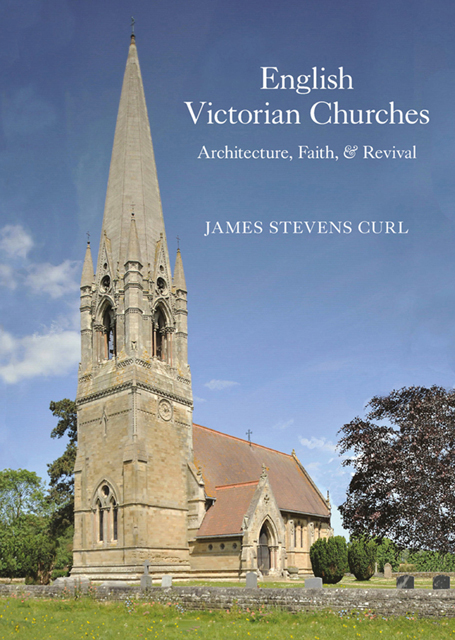Book contents
- Frontmatter
- Dedication
- Contents
- Foreword by Barry Orford
- Preface and Acknowledgements
- Note on Illustrations
- 1 An Introduction to Denominations and Victorian Churches
- 2 Architecture, Antiquarianism, and Styles
- 3 The Religious Atmosphere in the 1830s and 1840s
- 4 Recusants, Goths, Converts, Ultramontanes, and Controversies
- 5 The Anglican Revival
- 6 The Search for an Ideal
- 7 Church Architecture of the 1850s, 1860s, and Early 1870s
- 8 The Late Victorian Anglican Church in Several Manifestations
- 9 Non-Anglican Buildings for Religious Observance
- 10 Epilogue
- Select Glossary
- Select Bibliography
- Index
8 - The Late Victorian Anglican Church in Several Manifestations
Published online by Cambridge University Press: 08 June 2023
- Frontmatter
- Dedication
- Contents
- Foreword by Barry Orford
- Preface and Acknowledgements
- Note on Illustrations
- 1 An Introduction to Denominations and Victorian Churches
- 2 Architecture, Antiquarianism, and Styles
- 3 The Religious Atmosphere in the 1830s and 1840s
- 4 Recusants, Goths, Converts, Ultramontanes, and Controversies
- 5 The Anglican Revival
- 6 The Search for an Ideal
- 7 Church Architecture of the 1850s, 1860s, and Early 1870s
- 8 The Late Victorian Anglican Church in Several Manifestations
- 9 Non-Anglican Buildings for Religious Observance
- 10 Epilogue
- Select Glossary
- Select Bibliography
- Index
Summary
Where the Chancel can be of considerable length, then there is no doubt that a high Rood Screen is the greatest possible ornament to the interior, but … requires very considerable depth behind it to give it its true value. It is curious, however, the prejudice one frequently meets against a Screen.
Temple Lushington Moore (1856–1920): Architectural Association Journal, xxii (1907), 36.Bodley fills an important position in the history of English ecclesiastical architecture. If Pugin, Scott, and Street were the pioneers whose work went hand in hand with the Oxford movement in its early days, Bodley is their counterpart in the last quarter of the nineteenth century.
Paul Waterhouse (1861–1924): Entry on Bodley in The Dictionary of National Biography Supplement(January 1901–December 1911) (Oxford: Oxford University Press, 1920), 189.Introduction
At Bodley & Garner’s St Augustine’s, Pendlebury, the dominant architectural theme is structure, and the interior is one great space. Another church, the design of which goes even further as a celebration of one huge Sublime volume, is St Bartholomew’s, Brighton (1872–4), by Edmund Evan Scott for the Anglo-Catholic Arthur Wagner. When the latter’s father, H.M. Wagner, became Vicar of Brighton and West Blatchington in 1824 there were only the mediæval parish church of St Nicholas and a couple of proprietary chapels to minister to Anglicans: when A.D. Wagner died in 1902 there were 17 churches, 5 of which, lavishly fitted out for High Anglican worship, were paid for out of his own pocket. Of those five, shamefully, two (All Saints’ and St Anne’s) have been demolished.
Arthur Wagner imbibed his Ecclesiology at Cambridge in the 1840s: from the start of his career he was a convinced Ritualist. Fabulously rich through inherited wealth (the Wagners, originally from Germany, settled in London in 1717, and became hatters to both royalty and the British Army), his life was devoted to building churches for the care of all, especially the poor, in Brighton. He became vicar when a parish was assigned to Carpenter’s St Paul’s, in 1873. Wagner not only beautified St Paul’s, but financed the erection of other Brighton churches, including the Annunciation (begun 1864 to designs by William Dancy, with later work from 1881 by E.E. Scott, F.T. Cawthorn, and Martin Travers), the enormous St Bartholomew’s, and the magnificent St Martin’s (1874–5 – the first major work by Somers Clarke, with later fittings unsurpassed for their date).
- Type
- Chapter
- Information
- English Victorian ChurchesArchitecture, Faith, and Revival, pp. 139 - 168Publisher: Boydell & BrewerPrint publication year: 2022



